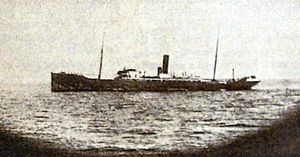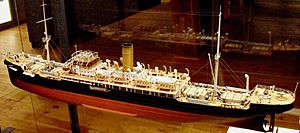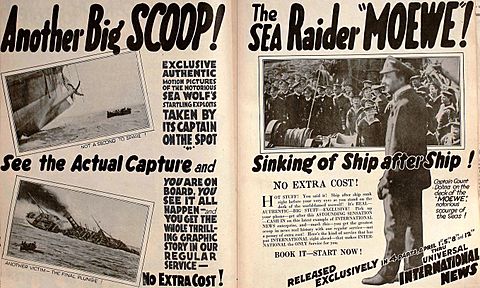SMS Möwe (1914) facts for kids
 |
|
Quick facts for kids History |
|
|---|---|
| Namesake | Möwe, German for "seagull" |
| Ordered | Laeisz |
| Builder | Joh. C. Tecklenborg Ship Yard, Geestemünde |
| Launched | 1914 as Pungo |
| In service | 1 November 1915 |
| Fate | Awarded as war reparations to the United Kingdom, sunk as German freighter Oldenburg 7 April 1945 |
| General characteristics | |
| Displacement | 9,800 tons (4,788 gross register tons (GRT)) |
| Length | 123.7 m |
| Beam | 14.4 m |
| Draught | 7.2 m |
| Propulsion | 1 × 3-cylinder triple expansion; 5 × boiler; 3,200 hp |
| Speed | 13 knots |
| Range | 8,700 nm at 12 kn |
| Complement | 235 |
| Armament |
|
SMS Möwe (which means "Seagull" in German) was a special kind of warship called a merchant raider. She belonged to the Imperial German Navy during World War I. Her job was to attack and sink ships belonging to the Allied countries.
The Möwe was very clever. She looked like a normal cargo ship to get close to her targets. This trick worked well, and she sank 40 ships during the war.
Contents
The Möwe's Early Days
The ship was built in 1914 by the Joh. C. Tecklenborg shipyard. She was first named Pungo and worked as a freighter, carrying bananas. She sailed from the German colony of Kamerun (now Cameroon) to Germany.
Later, the Imperial German Navy took over the Pungo. They changed her into a minelayer, a ship that lays underwater mines. This change happened in late 1915. On November 1, 1915, she officially joined the navy as SMS Möwe. Her commander was Nikolaus zu Dohna-Schlodien.
First Secret Mission
The Möwe left Wilhelmshaven on December 29, 1915. Her first mission was to lay mines in the Pentland Firth. This area was near Scapa Flow, a big base for the British navy. She completed this task even in bad weather.
A few days later, a British battleship, HMS King Edward VII, hit one of her mines and sank. The Möwe then moved south, laying another minefield off the coast of France. Two more ships sank there.
After this, Möwe sailed into the Atlantic Ocean. She operated near Spain, the Canary islands, and later off the coast of Brazil.
Battle of January 16, 1916
This was a fight between the German Möwe and a British cargo ship. It happened near the Portuguese islands of Madeira in the Atlantic.
The Möwe was sailing with another ship, Appam. The Appam was a British ship that Möwe had captured. It had a German crew and many prisoners of war. As the sun set, lookouts on Möwe saw smoke, meaning another ship was nearby.
Kapitän Dohna-Schlodien told Appam to stay back. He went to check out the ship. It was dark when Möwe got closer. The ship was a large merchant vessel, later identified as Clan Mactavish.
Dohna-Schlodien used a signal lamp to ask the cargo ship's name. Clan Mactavish asked Möwe to identify herself first. Dohna-Schlodien lied, saying his ship was Author, a British ship. Möwe looked very similar to the Author, which had been sunk earlier. Clan Mactavish then gave her real name. She said she was returning to Britain from Australia.
Now that he knew it was a British ship, Dohna-Schlodien ordered Clan Mactavish to stop. But Clan Mactavish turned and sped up, trying to escape. Möwe fired warning shots and chased her. Clan Mactavish fired back with her single gun, but missed. The German ship was not hit.
Möwe then fired her four big 150 mm guns. Clan Mactavish sent out emergency radio signals. A British armored cruiser, HMS Essex, received them. But the radio operator on Essex did not tell his officers, so no help was sent.
After being hit many times, Clan Mactavish caught fire. Her captain surrendered to Möwe. A group of German sailors went onto Clan Mactavish. They took the surviving crew as prisoners. Eighteen crew members were killed, and five were wounded. The captain of Clan Mactavish was a navy reservist, and two navy gunners operated her gun. The rest of the crew were civilians.
The German sailors then sank Clan Mactavish using explosives. After the battle, Möwe met up with Appam again. They sailed west to avoid any British warships. Two British cruisers were not far away. If the Essex had reported the distress call, Möwe might have been caught.
Möwe continued to sink more Allied ships before returning home. When she arrived, Kapitän Dohna-Schlodien received the Iron Cross medal. Felix von Luckner, another famous German raider, served on SMS Möwe before his own adventures.
A New Name: Vineta
To keep her secret, Möwe was renamed Vineta. This was the name of another German ship that was no longer in service. As Vineta, she made short trips in the summer of 1916. She attacked Allied ships off the coast of Norway. She only had one success before being sent for repairs.
Second Raiding Mission
Möwe left on November 23, 1916, for her second trip into the Atlantic. This mission was even more successful.
On December 6, 1916, she captured and sank the Canadian ship SS Mount Temple. This ship was carrying 700 horses for the Canadian army in France. It also had many crates of dinosaur fossils! These fossils were from Alberta, Canada, and were going to the British Museum. On December 12, she sank SS Georgic, which was carrying 1,200 horses for the war.
In four months, Möwe sank or captured 25 more ships. One of these, SS Yarrowdale, was sent back to Germany. It was then turned into another commerce raider, just as Dohna-Schlodien had suggested. Möwe also kept SS Saint Theodore to use as a coal ship. Later, she armed Saint Theodore and renamed her Geier. Geier sank two ships before Möwe disarmed and sank her.
On March 10, Möwe was damaged in a fight with a New Zealand merchant ship, Otaki. The Otaki had one gun and fought bravely. Möwe was hit several times and had a serious fire. But the Otaki was hit about thirty times and sank. The captain of the Otaki, Archibald Bisset Smith, was given a special medal for his bravery. This damage forced Möwe to return to Germany.
In March 1917, Möwe successfully got through the British blockade again. She arrived home safely on March 22, 1917.
Later Years
After her return, Möwe was no longer used as a raider. She was too important as a symbol of German success to risk again. She served in the Baltic as a ship that supported submarines. In 1918, she became a minelayer called Ostsee.
After World War I ended, Möwe was given to Britain. She worked as a freighter named Greenbrier. In 1933, a German company bought her. As the freighter Oldenburg, she sailed between Germany and occupied Norway during World War II.
On April 7, 1945, she was attacked by British aircraft near Vadheim, Norway. The planes fired rockets and cannons at her. She caught fire, sank, and was lost forever.
Möwe's Amazing Success
In her three raiding trips, Möwe captured and sank 40 ships. She also laid mines that sank two more ships and a large warship. This made her the most successful German raider in both World Wars.
| Date | Ship | Type | Nationality | Tonnage GRT | Fate |
|---|---|---|---|---|---|
| 11 Jan 16 | Corbridge | Cargo ship | 3,687 | Retained as prize; scuttled 30 Jan 16 | |
| 11 Jan 16 | Farringford | Cargo ship | 3,146 | sunk | |
| 13 Jan 16 | Dromonby | Cargo ship | 3,627 | sunk | |
| 13 Jan 16 | Author | Cargo ship | 3,496 | sunk | |
| 13 Jan 16 | Trader | Cargo ship | 3,608 | sunk | |
| 15 Jan 16 | Ariadne | Cargo ship | 3,035 | sunk | |
| 15 Jan 16 | Appam | Cargo ship | 7,781 | Retained as prize; detached 17 Jan 16; returned 28 Mar 17 | |
| 16 Jan 16 | Clan McTavish | Cargo ship | 5,816 | sunk in action | |
| 20 Jan 16 | Edinburgh | Sailing ship | 1,473 | sunk | |
| 4 Feb 16 | Luxembourg | Cargo ship | 4,322 | sunk | |
| 6 Feb 16 | Flamenco | Cargo ship | 4,540 | sunk | |
| 8 Feb 16 | Westburn | Cargo ship | 3,300 | Retained as prize; detached 9 Feb 16 to Santa Cruz de Tenerife | |
| 9 Feb 16 | Horace | Cargo ship | 3,109 | sunk | |
| 24 Feb 16 | Maroni | Cargo ship | 3,109 | sunk | |
| 25 Feb 16 | Saxon Prince | Cargo ship | 3,471 | sunk |
| Date | Ship | Type | Nationality | Tonnage GRT | Location |
|---|---|---|---|---|---|
| 6 Jan 16 | King Edward VII | Pre-dreadnought battleship | 16,350 t disp | Scotland | |
| 13 Jan 16 | Bayo | Cargo ship | 2,776 | Gironde | |
| 13 Jan 16 | Belgica | Cargo ship | 2,068 | Gironde | |
| 22 Feb 16 | Duckbridge | Cargo ship | 1,491 | Scotland |
| Date | Ship | Type | Nationality | Tonnage GRT | Fate |
|---|---|---|---|---|---|
| 27 Jul 16 | Eskimo | Cargo ship | 3,326 | Taken as a prize |
| Date | Ship | Type | Nationality | Tonnage GRT | Fate |
|---|---|---|---|---|---|
| 2 Dec 16 | Voltaire | Cargo ship | 8,618 | sunk | |
| 4 Dec 16 | Hallbjørg | Cargo ship | 2,586 | sunk | |
| 6 Dec 16 | Mount Temple | Cargo ship | 9,792 | sunk | |
| 8 Dec 16 | Duchess of Cornwall | Sailing ship | 152 | sunk | |
| 8 Dec 16 | King George | Cargo ship | 3,852 | sunk | |
| 9 Dec 16 | Cambrian Range | Cargo ship | 4,235 | sunk | |
| 10 Dec 16 | Georgic | Cargo ship | 10,077 | sunk | |
| 11 Dec 16 | Yarrowdale | Cargo ship | 4,652 | retained as prize; detached to Swinemunde, 31 Dec 16. Converted to auxiliary cruiser Leopard |
|
| 12 Dec 16 | Saint Theodore | Cargo ship | 4,992 | Commissioned as auxiliary cruiser Geier; scuttled 14 Feb 17 |
|
| 18 Dec 16 | Dramatist | Cargo ship | 5,415 | sunk | |
| 26 Dec 16 | Nantes | Sailing ship | 2,679 | sunk | |
| 2 Jan 17 | Asnieres | Sailing ship | 3,103 | sunk | |
| 5 Jan 17 | Hudson Maru | Cargo ship | 3,798 | sunk/released | |
| 7 Jan 17 | Radnorshire | Cargo ship | 4,310 | sunk | |
| 9 Jan 17 | Minteh | Cargo ship | 2,890 | sunk | |
| 10 Jan 17 | Netherby Hall | Cargo ship | 4,461 | sunk | |
| 15 Feb 17 | Brecknockshire | Cargo ship | 8,423 | sunk | |
| 16 Feb 17 | French Prince | Cargo ship | 4,766 | sunk | |
| 16 Feb 17 | Eddie | Cargo ship | 2,652 | sunk | |
| 24 Feb 17 | Katherine | Cargo ship | 2,926 | sunk | |
| 4 Mar 17 | Rhodanthe | Cargo ship | 3,061 | sunk | |
| 10 Mar 17 | Esmeraldas | Cargo ship | 4,678 | sunk | |
| 10 Mar 17 | Otaki | Cargo ship | 9,575 | sunk in action | |
| 13 Mar 17 | Demeterton | Cargo ship | 6,048 | sunk | |
| 14 Mar 17 | Governor | Cargo ship | 5,524 | sunk |
Film
In 1917, a German film company made a propaganda film about Möwe. It was called Graf Dohna und seine Möwe (Count Dohna and his Möwe). It was one of the most famous war films of World War I.
See also
- Naval warfare of World War I



